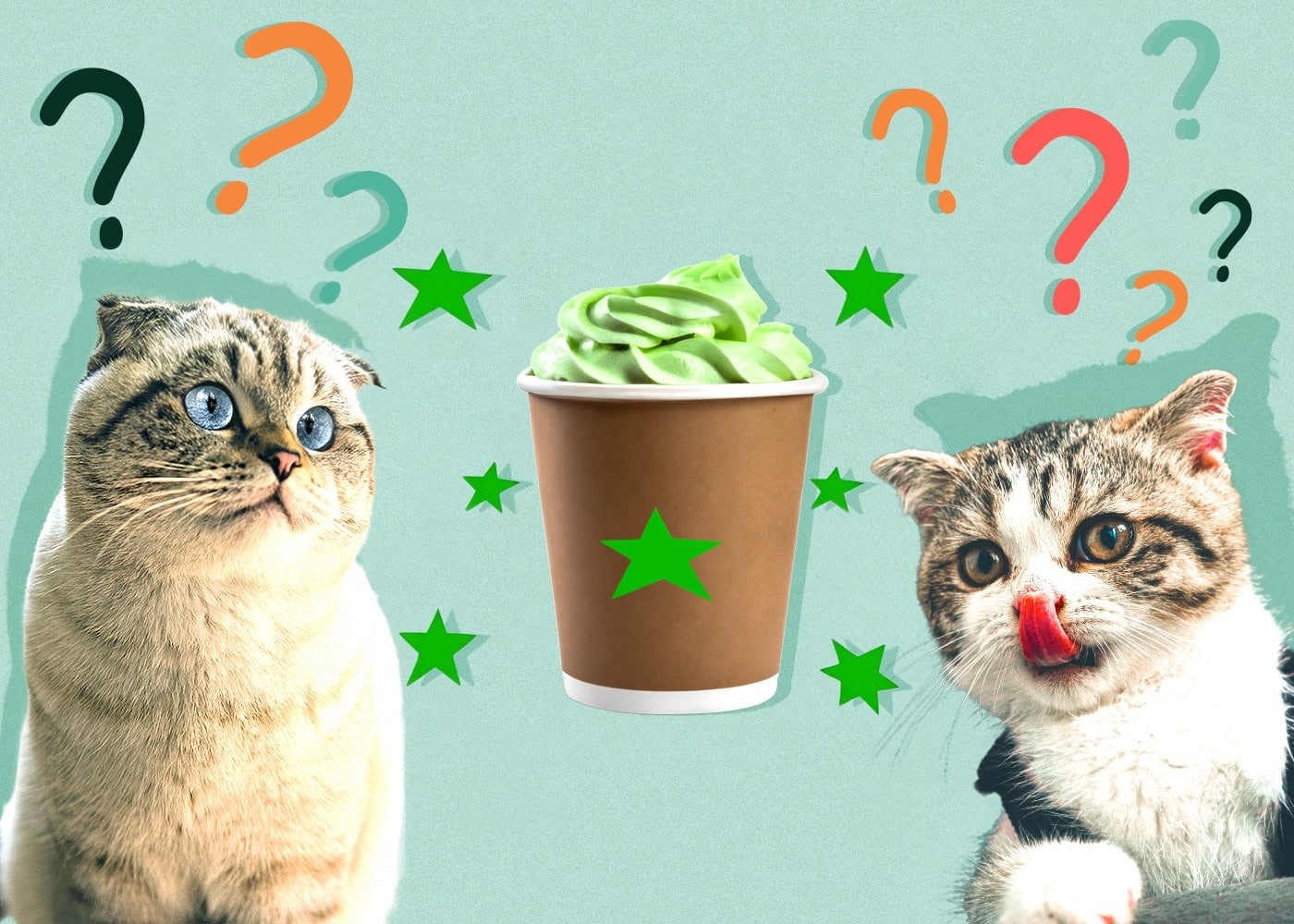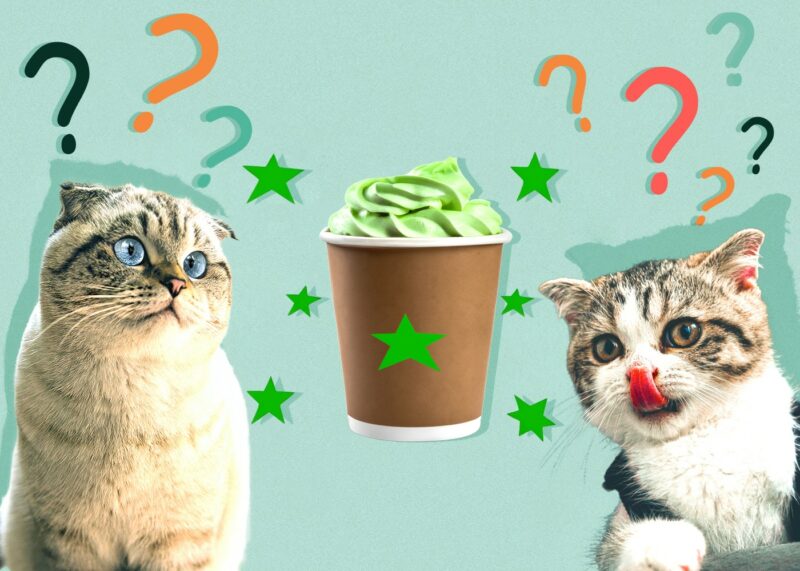With many baristas snapping pics of canine customers in the drive-through, treating your dog to a pup cup has taken the influencer world by storm. This free item from Starbucks’ “secret menu” is beloved by dog companions everywhere. Still, we can’t help but wonder about our other pets.
Some more adventurous cats may accompany their owners on road trips and find themselves missing out on treats at Starbucks. If dogs can eat pup cups, can cats eat them too? And most importantly, should they? Yes, cats can have Puppuccinos! There are no ingredients in this doggy treat that are toxic to cats. However, it is not very healthy for them or recommended. let’s dive into more details you should know about the topic.

Can Cats Have Puppuccinos?
Pup cups are high in sugar, calories, and flavoring. Additionally, Puppuccinos contain large amounts of lactose, which cats struggle to digest. A pup cup should not be part of a cat’s healthy diet, but many enjoy the creamy taste. Ask your barista for a cat-sized portion so your cat doesn’t overindulge, but even a small amount could upset your cat’s stomach.
What Is a Puppuccino?
Many wonder how Starbucks can afford to have a free item on its menu, but a pup cup has a single ingredient. A cappuccino is simply a tiny cup, usually espresso-size, of whipped cream.
Nothing fancy, right?
However, whipped cream contains more than just heavy cream. Here’s the complete list of Starbucks’ whipped cream recipe:
- Cream
- Sugar
- Propellants: nitrous oxide, nitrogen
- Emulsifier: E471
- Flavoring (vanilla syrup)
- Carrageenan (stabilizer)
This extended ingredient list makes Starbucks whipped cream extra tasty and fluffy. To dive a bit deeper, let’s look at the ingredients in Starbucks vanilla syrup, which serves as a flavoring in their whipped cream.
- Sugar
- Water
- Natural flavor
- Potassium sorbate (preservative), citric acid
There’s a lot more than meets the eye, huh? There are a few concerning ingredients in a pup cup for cats. Let’s break it down.
Are Puppuccinos Healthy for Cats?
The unfamiliar words in these ingredients may have you second-guessing whether a pup cup is okay for your cat. However, chemical-sounding names such as carrageenan and potassium sorbate are safe and approved ingredients in cat foods.
The more common words are the ones that are unsuitable for a cat’s diet—cream, sugar, citric acid. Puppuccinos are not going to harm your cat if they are otherwise healthy.
A small portion will be an adored treat for your cat, but it should not be a regular part of their diet.
Cream
Dairy products contain lactose at varying levels. For kittens, lactose is important since it aids healthy growth and development. But as cats reach adulthood, the amount of lactase in their bodies reduces, and they lose the ability to break down lactose efficiently.
Ultimately, dairy products should be avoided in a cat diet. Small amounts generally won’t cause harm unless they have a more severe intolerance. Additionally, cream products are significantly lower in lactose than raw milk.
So, while pup cups aren’t great for cats, they shouldn’t cause an upset stomach.
Sugar
Additional sugar in whipped cream turns a bland product into an incredible-tasting one. That’s true for humans but not for cats. Cats can’t taste sweet flavors and probably enjoy the pup cup from the fat and protein contained in dairy.
Sugar is not required to be added to a cat’s diet; in fact, large amounts can do some serious harm. High blood sugar levels are linked to diabetes and obesity. Keep your cat’s Starbucks visits to a bare minimum.
Citric Acid
Hidden deep within the ingredients is a compound called citric acid, which is used to enhance the flavor of the vanilla syrup. Citric acid can be toxic to cats, causing gastrointestinal upset and, in extreme cases, nerve damage.
However, don’t panic: the amount of citric acid in a pup cup is so minor it won’t affect your cat. Just be mindful of portion sizes and the regularity of consumption.
Nutritional Value
With a cream base, pup cups are high in calories. Whipped cream has approximately 60 calories per 20 grams. A standard Starbucks espresso cup holds around 3 ounces or 85 grams. So, a pup cup in espresso size contains a whopping 255 calories.
Vets recommend that indoor cats have 20 calories per pound of body weight. So, an average 15-pound cat requires only 300 calories in a day. A Puppuccino treat can blow those calories out of the water without providing nutritional value. Again, this is okay in rare events, but it will cause weight gain when consumed frequently.
Learning about what your cat can and cannot eat is a crucial part of keeping them happy and healthy! Choosing a bowl to serve cat-friendly foods in is another important decision pet owners face. Satisfy the specific needs of your cat with the innovative design of the Hepper NomNom Cat Bowl. Learn why it’s our (and our cats!) favorite food and water dish here. At Catster, we’ve admired Hepper for many years and decided to take a controlling ownership interest so that we could benefit from the outstanding designs of this cool cat company!
Final Thoughts
The pup cup is a high-calorie and lactose-dense treat that is unhealthy for cats. Don’t let the freebie marketing ploy suck you in; there are plenty of healthy treats out there that your cat will love—even if they are not as Instagram-worthy!
See Also
Featured Photo Credit: Monarexx, Shutterstock












